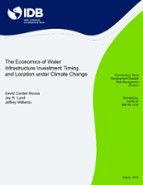The Economics of Water Infrastructure Investment Timing and Location under Climate Change
Date
Aug 2016
The Dong Nai Delta in Vietnam has been projected to face long-term changes in physical conditions stemming from climate change. Sea level rise combined with changes in the hydrologic cycle will result in increased salinity conditions, causing significant damage to the current style of agricultural production. Adapting to these changes in salinity will require not only adjusting the cropping patterns, but also new water infrastructure investments. Two important questions arise for planners and practitioners. First, a balance needs to be found with regards to the appropriate timing of the investment. An important amount of investment is needed for new water infrastructure while salinity will increase gradually over time. Second, considerable tradeoffs exist with respect to the location of the investment arising from the morphological characteristics of the delta. Constructing water infrastructure closer to the sea implies a higher investment cost. However, the additional benefits will be reduced since regions closer to the sea already have lower agricultural productivity due to greater salinity. This paper develops an economic model to analyse the optimal timing and location of water infrastructure investments in the Dong Nai Delta of Vietnam.



